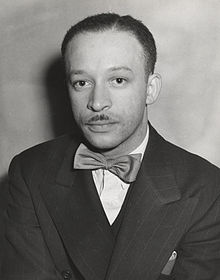 Charles Henry Alston (November 28, 1907 – April 27, 1977) was an African-American painter, sculptor, illustrator, muralist and teacher who lived and worked in the New York City neighborhood of Harlem. Alston was active in the Harlem Renaissance; Alston was the first African-American supervisor for the Works Progress Administration's Federal Art Project. Alston designed and painted murals at the Harlem Hospital and the Golden State Mutual Life Insurance Building. In 1990 Alston's bust of Martin Luther King, Jr. became the first image of an African American displayed at the White House.
Charles Henry Alston (November 28, 1907 – April 27, 1977) was an African-American painter, sculptor, illustrator, muralist and teacher who lived and worked in the New York City neighborhood of Harlem. Alston was active in the Harlem Renaissance; Alston was the first African-American supervisor for the Works Progress Administration's Federal Art Project. Alston designed and painted murals at the Harlem Hospital and the Golden State Mutual Life Insurance Building. In 1990 Alston's bust of Martin Luther King, Jr. became the first image of an African American displayed at the White House.Experimenting with the use of negative space and organic forms in the late 1940s, by the mid-1950s Alston began creating notably modernist style paintings. Woman with Flowers (1949) has been described as a tribute to Modigliani and African art makes another strong appearance in Ceremonial (1950). Untitled works during the era show his use of color overlay using muted colors to create simple layered abstracts of still live..
Symbol (1953) relates to Picasso's Guernica, which was a favorite work of Alston's. His final work of the 1950s, Walking serves as a precursor to the 1960s: civil rights movement. The painting, which was inspired by the Montgomery Bus Boycott, has come to represent "the surge of energy among African Americans to organize in their struggle for full equality." About the artwork, Alston is quoted "The idea of a march was growing...It was in the air...and this painting just came. I called it Walking on purpose. It wasn't the militancy that you saw later. It was a very definite walk-not going back, no hesitation."
The civil rights movement of the 1960s was a major influence on Alston. Considered to be one of his most powerful and impressive periods in the late 1950s he began working in black and white up until the mid-1960s. Some of the works are simple abstracts of black ink on white paper, similar to a Rorschach test. Untitled (c. 1960s) shows a boxing match in great simplicity with an attempt to express the drama of the fight through few brushstrokes. Alston worked with oil-on-Masonite during this period as well, utilizing impasto, cream and ochre to create a moody cave-like artwork. Black and White #1 (1959) is one of Alston's more "monumental" works. Gray, white and black come together to fight for space on an abstract canvas, in a softer form than the more harsh Franz Kline. Alston continued to explore the relationship between monochromatic hues throughout the series which Wardlaw describes as "some of the most profoundly beautiful works of twentieth-century American art."
Alston also created sculptures. Head of a Woman (1957) shows his move towards a "reductive and modern approach to sculpture....where facial features were suggested rather than fully formulated in three dimensions,". In 1970 Alston was commissioned by the Community Church of New York to create a bust of Martin Luther King Jr. for $5,000, with limited copies produced. In 1990 Alston's bronze bust of Martin Luther King Jr. (1970), became the first image of an African American displayed in the White House.
Charles Alston select paintings:
Sources: Africanah, Michael Rosenfeld Art